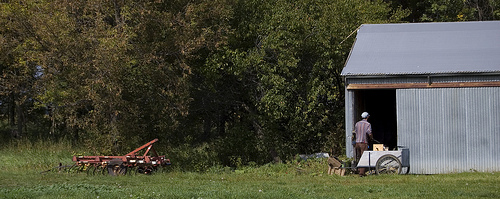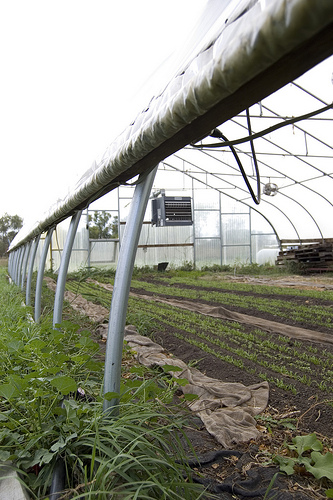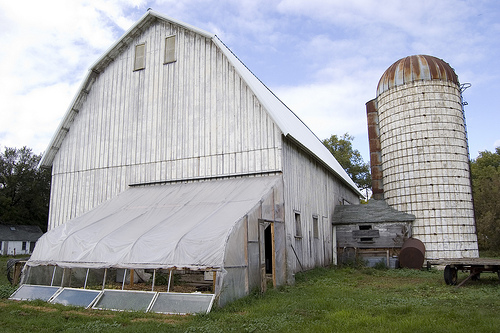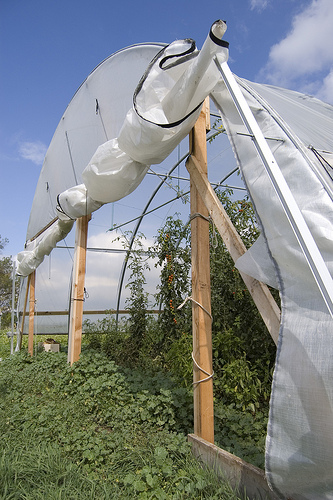Assessing & Planning
Infrastructure
When Adam and Laura rented land, most of their infrastructure was also rented from Gardens of Eagan. They rented space in the greenhouse each spring to raise seedlings and transplants. In 2005, they also rented cooler space and built a lean-to for use as their packing area. They bought their own small cooler in 2006, placing it underneath the lean-to as shown in Figure 12.
Figure 12: The cooler and lean-to used as a packing area on Laura and Adam's rented land. They did not use the pole barn to which the lean-to is attached. Their rented field is the land in front of the lean-to.
Because Laura and Adam purchased an operating farm, much of the infrastructure they needed for Loon Organics was in place when they arrived in October 2008.

Figure 13: Adam enters the shed that they use to store and work on their collection of tractors.
| Aside from the barn and irrigation system mentioned under Farm Description, their new farm already had a farmhouse, two greenhouses, and two sheds. One shed serves as Adam’s machine workshop (Figure 13). The other shed is a refurbished granary; they use half for tractor storage, and the other half provides living quarters for one to two people (Figure 14). |
Farmer’s Perspective: Lessons Learned It’s Always Something… The need for infrastructure upgrades is often overlooked when budgeting for a farm purchase. A new septic system or well may be needed, for example. In Adam and Laura’s case, the necessary electrical system upgrade cost $5,734. |
Figure 14: The refurbished granary provides on-site living quarters for farm employees.
The primary greenhouse on the new farm is a 30’ x 48’ Gothic-style greenhouse that is heated with propane (Figure 15).
Figure 15: Radishes, salad mix, and turnips growing in raised beds in the primary greenhouse on May 5.
 |
Because it has roll-up sides and raised beds on one side, it can also be used for season extension without a mechanical heat source (Figure 16). These same flexible walls make it inefficient to heat through winter nights, however. Adam and Laura are exploring options such as in-ground heating to make their greenhouse operation more economical. |
| Figure 16: The primary greenhouse with its sides rolled up and newly sprouted seedlings in its raised beds on September 23. |
The second greenhouse is a lean-to structure off the south side of the barn (Figure 17). They use it as an overflow greenhouse and for hardening off transplants. They are planning some structural and functional improvements so they can increase its use.

Figure 17: Laura and Adam's secondary greenhouse, attached to the barn.
| Laura and Adam’s major addition to farm infrastructure to date is a 30’ x 96’ Quonset-style (round roof) hoop house (Figure 18). They purchased a kit that included the plastic, hoops, and ground posts for $5,713 in 2008 (Figure 19). They spent approximately another $1,000 on end walls. In 2010, they plan to add better support beams for trellising crops at a cost of about $500. Their experience with this “pilot” hoop house is described further under Hoop House Production. |  Figure 18: Adam and Laura added what they hope is one of several hoop houses to their new farm for season extension. |
Figure 19: Laura and Adam constructed the hoop house themselves (with lots of help) over a 2-3 week period.
| Educator’s Perspective: Resource Tip Greenhouse vs. Hoop House Hoop houses, or high tunnels, are unheated greenhouses used for extending the growing season. ATTRA has a comprehensive resource list for greenhouses, including a section on hoop houses. Hightunnels.org also has extensive hoop house resources as part of a USDA-sponsored project that is testing and promoting high tunnel systems in the Central Great Plains. MISA and MOSES co-developed a season extension Web site that includes on-farm trials from the Midwest. The University of Minnesota High Tunnel Production site is dedicated to furthering high tunnel research on fruit and vegetable crops in Minnesota. A news release in late 2009 announced that the USDA Natural Resources Conservation Service would be funding hoop houses on farms in 38 states as part of a 3-year pilot study to increase availability of locally grown foods. |